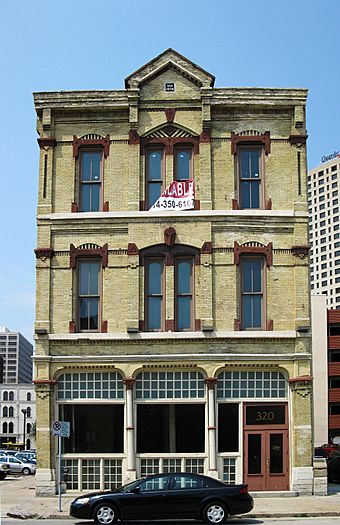Wisconsin Leather Company Building facts for kids
Quick facts for kids |
|
|
Wisconsin Leather Company Building
|
|

Wisconsin Leather Company Building
|
|
| Location | 320 E. Clybourn St. Milwaukee, Wisconsin |
|---|---|
| Built | 1874 |
| Architect | E. Townsend Mix |
| Architectural style | Italianate |
| NRHP reference No. | 05000250 |
| Added to NRHP | March 30, 2005 |
The Wisconsin Leather Company Building was built in 1874 in Milwaukee, Wisconsin. It served as the main office and store for one of Milwaukee's first and largest leather companies. This important building was added to the National Register of Historic Places in 2005.
Contents
Making Leather in Old Milwaukee
Back in the 1800s, making leather was a big business! It needed a few key things:
- Animal skins (like from cows)
- Special stuff called "tanning agents"
- Lots of water
Tanning agents came from the bark of trees like oak and hemlock. These agents helped turn raw animal skins into strong, usable leather.
Milwaukee was a great place for leather making. Why?
- Northern Wisconsin had huge forests of hemlock trees.
- The Midwest had plenty of animal skins.
- The Milwaukee River provided water for cleaning and for moving goods.
- The Great Lakes helped transport leather to other places.
The very first leather factory, called a tannery, in Milwaukee started in 1842. It was opened by Daniel Phelps.
The Wisconsin Leather Company Story
The story of the Wisconsin Leather Company began far away in New York. A man named Rufus Allen, Sr. had a tannery there since 1809. But by the 1840s, they had used up most of the tanning tree bark. So, his family moved west to Milwaukee.
In 1846, Rufus's son William Allen teamed up with Edward P. Allis. They opened the Empire Leather Store in Milwaukee. They sold all kinds of leather, like sole leather for shoes and harness leather for horses. By 1850, their business was known as the "Wisconsin Leather Company."
Growing the Business
The company grew quickly! In 1850, they bought a lot of hemlock forest land. They built a huge tannery in a place called Two Rivers, Wisconsin. This tannery made "upper leather," which is used for the top part of shoes.
Supplies were sent from Milwaukee to Two Rivers. The finished leather was then shipped back to Milwaukee. The Two Rivers tannery was very big for its time. It had 134 tanning vats and processed 60,000 animal hides each year!
By 1870, the company built another large tannery. This one was in the Kinnickinnic area of Milwaukee. It was designed to make leather for harnesses and other uses. People said it was the biggest tannery of its kind in the whole country! By 1872, Wisconsin Leather was one of the largest leather makers in the United States.
The Company's Main Building
In 1874, the Wisconsin Leather Company decided to build a new main office and store in Milwaukee. This is the building we are talking about! A famous architect named E. Townsend Mix designed it.
The building is made of cream-colored brick and has three stories. It was built in the Italianate style. You can see this style in the fancy designs above the windows and the tall, flat columns on the corners. The top of the building has a decorative border called a cornice. The storefront, with its metal columns, was likely added around 1890.
Changes Over Time
The Wisconsin Leather Company officially became a corporation in 1881. However, things started to change. Their tannery in Two Rivers closed in 1887 because there wasn't enough tree bark left. In the same year, the company faced money problems.
By 1889, a competing company bought what was left of Wisconsin Leather. The leather industry in Milwaukee continued to be important for many more years, especially during World War I.
The building itself found a new owner in 1885. Charles L. Kiewert bought it and sold supplies for brewing and bottling there until 1920.

